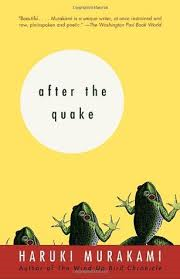After the Quake by Haruki Murakami

I’m a fan of Haruki Murakami’s writing, but I was unable to connect to any of the characters or plots in the six short stories in the collection After the Quake. I’m struggling to express why exactly, the closest I can come to is that I think these stories need to be read in their original language (Japanese) by people who experienced the 1995 Kobe earthquake, which the stories are centered around.
In the first story, UFO in Kushiro, a husband and wife separate after soon after the earthquake. The wife tells her husband there is nothing inside of him that he can give her. He is devastated, but eventually gets a glimpse of his future self, which leaves him with some hope.
The second story, Landscape with Flatiron, tells of two suicidal people who live to have bonfires on the beach. If there was a moral or a point to this story, it went over my head.
All God’s Children Can Dance is the story of a man whose mother led him to believe he was like Jesus, in that he was the result of a virgin birth, although eventually the man sought out a person who he believed was his father.
Thailand tells the story of a spiritually-tired business woman who swims her way to peace while on vacation. Her chauffeur offers her guidance and enlightenment, both directly and indirectly.
Super-Frog Saves Tokyo, like many of this author’s stories, has super-natural elements. The hero of this story is able to help save Tokyo from a devastating earthquake with Frog, by dreaming and believing while Frog fought a terrible battle with Worm.
I enjoyed and related to Honey-Pie best of all the stories. Three friends from university, two men and a woman, almost lost their friendship when two of them fell in love. The pair married and had a child, but the other man was the better match for the woman and long-term, theirs would be the relationship that lasted. The child dreamed of ‘The Earthquake Man’ which is something I imagine many Japanese children who lived through the Kobe earthquake did.
After the Quake isn’t my favourite of Haruki Murakami’s works, but his ‘okay’ is still better than most writer’s ‘best’.
 I enjoyed Haruki Murakami’s memoir, What I Talk About When I Talk About Running, loads more than his novels, Colourless Tsukura Tazaki and His Years of Pilgrimage or The Strange Library, as good as they were.
I enjoyed Haruki Murakami’s memoir, What I Talk About When I Talk About Running, loads more than his novels, Colourless Tsukura Tazaki and His Years of Pilgrimage or The Strange Library, as good as they were.

Recent Comments